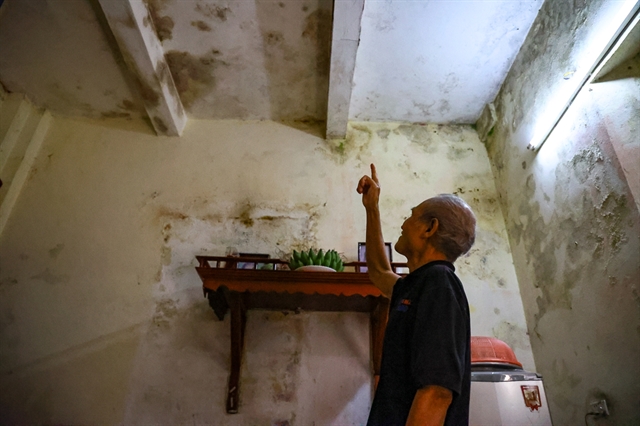 Society
Society

Phạm Đức Bách, 41, of Alley 74, Hàng Khoai Street, Hoàn Kiếm District, applauded after hearing that his family might benefit from the city administration’s plan to relocate residents in four inner districts of Hà Nội from now until 2030.

|
| A degraded house of Trần Thị Dzung, of Alley No 61, Cửa Đông Street, Hoàn Kiếm District. —VNA/VNS Photo Trung Nguyên |
HÀ NỘI — Phạm Đức Bách, 41, of Alley 74, Hàng Khoai Street, Hoàn Kiếm District, applauded after hearing that his family might benefit from the city administration’s plan to relocate residents in four inner districts of Hà Nội from now until 2030.
Bách said three generations of his family had lived in the nearly-20sq.m house in the alley for many years.
In total, 15 people from three households live in the alley and have to share one toilet, he added.
“It’s very inconvenient,” he said.
Whenever guests visited his house, he had to take them to a coffee shop nearby because his house was too small and degraded, he added.
Bách said he always dreamed about having a bigger house.
“However, what I worry about the most is what to do to earn a living after moving to a new place,” he said.
Currently, his family makes an income from their phở (beef noodle soup) shop near the alley with many familiar customers, he said.
Similarly to Bách, Trần Thị Dzung, of Alley No 61, Cửa Đông Street, Hoàn Kiếm District, said she had lived in a nearly-20sq.m house deep in the alley for 15 years.
Her house was really degraded with many cracks in the walls, she said.
“The heat of summer often turns the house into a sauna while the rains cause the house to have many leaks,” she added.
Dzung had to use pots and pans to catch the water from the leaks, she said, adding that the attic floor was always covered with a plastic layer to avoid water seeping through the partitions.
Another resident living in Trung Yên Alley, Hàng Bạc Ward, Hoàn Kiếm District, said she and her neighbours expected that the plan would bring positive changes to people in the Old Quater.
People looked forward to the plan’s solutions, creating opportunities for people to do business and earn a living after they moved to a new place, she said.
More than 215,000 people living in four inner districts of Hà Nội are set to be relocated under an urban planning project which aims to decrease population density and upgrade infrastructure.
The city administration on Monday morning published maps detailing six urban planning zones in Hoàn Kiếm, Ba Đình, Đống Đa and Hai Bà Trưng districts, designed by the municipal Department of Planning and Architecture, covering an area of more than 2,700ha.
The plan hopes to reduce the population in the four districts from the current 887,000 to 672,000 by 2030.
The city’s plans to relocate residents from now until 2030 for land clearance and road expansion, while also relocating industrial parks, hospitals and headquarters of ministries and agencies out of the four districts to have space for public infrastructure and green space.
According to the maps, Hoàn Kiếm Lake and neighbouring areas have been identified as the capital’s famous scenic area and will act as a cultural, administrative, commercial, service, tourism centre combined with housing and community buildings for historical, cultural and religious activities.
The old streets will be the location of historical, cultural, religious relics, villas, houses, offices, commercial, financial, cultural, medical services and other community works.
Phạm Tuấn Long, Chairman of the People's Committee of Hoàn Kiếm District, said most of the houses in the district’s Old Quarter were quite degraded and the facilities and living conditions were inconvenient.
Today, demand for bigger houses was higher than in the past and many people wanted to move to a larger and more comfortable house, he said.
Therefore, the city’s administration carefully calculated to move which households with the purpose towards all people to enjoy the most favourable conditions, he said.
“The Old Quarter now needs to promote the value of heritage, tourism and trade,” he said. — VNS




